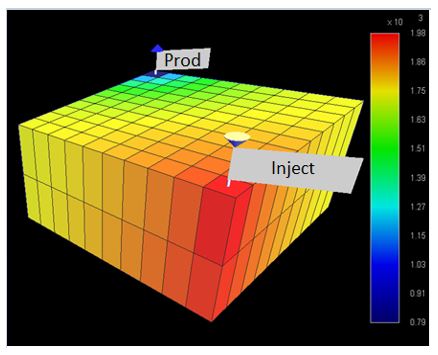The Key Parameter Effect Analysis Of Polymer Flooding On Oil Recovery Using Reservoir Simulation
DOI:
https://doi.org/10.25299/jgeet.2019.4.1.2107Keywords:
Polymer flooding, SOR reduction, polymer adsorptionAbstract
As time goes by, there will be decreasing of production rates of a field along with decreasing pressure. This led to the necessity for further efforts to increase oil production. Therefore, pressure support is required to improve the recovery factor. Supportable pressure that can be used can be either water flooding and polymer flooding. This study aims to compare recovery factor to scenarios carried out, such as polymer flooding with different concentrations modeled in the same reservoir model to see the most favorable scenario. The method used in this research is reservoir simulation method with Computer Modeling Group (CMG) STARS simulator. The study was carried out by observing at the pressure, injection rate, and polymer concentration on increasing field recovery factor. This study used cartesian grid with the assumption of homogeneous reservoir, there are no faults or other geological condition in the reservoir, and driving mechanism is only solution gas drive. This reservoir, oil type is light oil with API gravity 40.3˚API and layer of conglomerate rock. The simulation result performed with various scenarios provides a good result. Where the conditions case base case field recovery factor of 6.7%, and after water flooding produced 25.5% of oil, whereas with tertiary recovery method is polymer flooding was carried out with four concentrations of 640 ppm, 1,500 ppm, 3,000 ppm, and 4,000 ppm obtained optimum values at 4,000 ppm polymer concentration with recovery factor 28.9%, SOR reduction final value 0,5255, polymer adsorption of 818,700 ppm, reservoir final pressure 1,707 psi, and an increase in water viscosity to 0.94 cP.
Downloads
References
Cenk, T., Dike, P., Henny, A., Raul, M., 2017. Economic Comparison of Hydrocarbon Recovery under Injection of Different Polymers. SPE/IATMI Asia Pacific Oil Gas Conf. Exhib. https://doi.org/10.2118/186414-MS
Clarke, A., Howe, A.M., Mitchell, J., Staniland, J., Hawkes, L.A., 2016. How Viscoelastic-Polymer Flooding Enhances Displacement Efficiency. SPE J. 21, 0675–0687. https://doi.org/10.2118/174654-PA
El-Khatib, N.A.F., 2001. The Application of Buckley-Leverett Displacement to Waterflooding in Non-Communicating Stratified Reservoirs. SPE Middle East Oil Show. https://doi.org/10.2118/68076-MS
Erfando, T., Herawati, I., 2017. Analysis of Petroleum Downstream Industry Potential in Riau Province. J. Geosci. Eng. Environ. Technol. 2, 178–182. https://doi.org/10.24273/jgeet.2017.2.2.304
Erfando, T., Rita, N., Marliaty, T., 2017. Optimasi Laju Injeksi Pada Sumur Kandidat Convert to Injection (CTI) di Area X Lapangan Y. J. Earth Energy Eng. 6. https://doi.org/10.22549/jeee.v6i2.992
Gao, S., Jiang, Z., Zhang, K., Liu, H., Fu, Q., Yan, W., Fu, B., 2016. High Concentration Polymer Flooding Field Test With Well Infilling to Change Fluid Flowing Direction After Polymer Flooding. SPE EOR Conf. Oil Gas West Asia. https://doi.org/10.2118/179794-MS
Guo, H., 2017. How to Select Polymer Molecular Weight and Concentration to Avoid Blocking in Polymer Flooding? SPE Symp. Prod. Enhanc. Cost Optim. https://doi.org/10.2118/189255-MS
Li, K., Sun, W., Li, F., Qu, Y., Yang, Y., 2014. Novel Method for Characterizing Single-Phase Polymer Flooding. SPE J. 19, 695–702. https://doi.org/10.2118/152988-PA
Pertamina, 2016. Unpublished Report.
Rita, N., 2016. Analisis Sensitivitas Salinitas dan Adsorbsi Injeksi Surfaktan-Polimer Menggunakan Simulasi Reservoir Pada Reservoir Berlapis Lapangan NA. J. Earth Energy Eng. 5. https://doi.org/10.22549/jeee.v5i2.476
Rita, N., 2011. Analisa Sensitivitas Salinitas dan Adsorbsi Injeksi Surfaktan-Polimer Menggunakan Simulasi Reservoir Pada Reservoir Berlapis Lapangan NA. Univ. Islam Riau.
San Blas, P.A., Vittoratos, E.S., 2014. The Polymer in Polymer Flooding: Is its Value Overestimated? SPE Heavy Oil Conf. https://doi.org/10.2118/170104-MS
Sheng, J.J., Leonhardt, B., Azri, N., 2015. Status of Polymer-Flooding Technology. J. Can. Pet. Technol. 54, 116–126. https://doi.org/10.2118/174541-PA
Temizel, C., Nabizadeh, M., Kadkhodaei, N., Ranjith, R., Suhag, A., Balaji, K., Dhannoon, D., 2017. Data-Driven Optimization of Injection/Production in Waterflood Operations. SPE Intell. Oil Gas Symp. https://doi.org/10.2118/187468-MS
Tetegan, G., Lawal, K.A., Tendo, F., 2015. A simple aggregate parameter for comparing waterflood reservoirs. SPE Niger. Annu. Int. Conf. Exhib. https://doi.org/10.2118/178355-MS
Widyarso, A., Swadesi, B., Wisnu Aji Wibowo, S., 2006. STUDI LABORATORIUM PENGARUH INJEKSI POLIMER DENGAN BERBAGAI KONSENTRASI TERHADAP PENINGKATAN PEROLEHAN MINYAK PADA RESERVOIR KARBONAT. Ikat. Ahli Tek. Perminyakan Indones. 15–17.
Wu, X., Xiong, C., Xu, H., Zhang, J., Lu, C., Lu, X., Li, J., Cao, H., Zhang, N., Cui, G., Chen, J., Ye, Y., Jia, X., Lv, J., Yang, Z., 2015. A Novel Particle-Type Polymer and IOR/EOR Property Evaluation. Abu Dhabi Int. Pet. Exhib. Conf. https://doi.org/10.2118/177421-MS
Yang, L., Zhihua, W., Xianglong, Z., Shanzhe, W., 2015. Study on Emulsification Behavior and Optimized Separation Technology of High Concentration Polymer Flooding Produced Liquid in Daqing Oilfield. SPE Middle East Oil Gas Show Conf. https://doi.org/10.2118/172768-MS

Downloads
Published
Issue
Section
License
Copyright @2019. This is an open-access article distributed under the terms of the Creative Commons Attribution-ShareAlike 4.0 International License which permits unrestricted use, distribution, and reproduction in any medium. Copyrights of all materials published in JGEET are freely available without charge to users or / institution. Users are allowed to read, download, copy, distribute, search, or link to full-text articles in this journal without asking by giving appropriate credit, provide a link to the license, and indicate if changes were made. All of the remix, transform, or build upon the material must distribute the contributions under the same license as the original.










